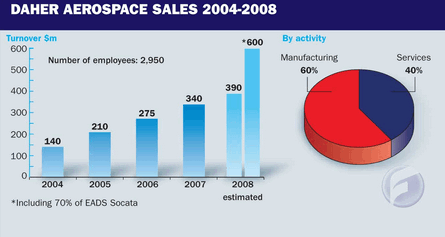A North American version of an overseas growth plan that has served it well in Morocco and exploitation of new prospects in aerostructures following its acquisition of a 70% stake in EADS Socata are the latest thrusts in Daher's long-term project of transforming itself into global tier 1 aerospace supplier.
Daher, which has always counted French original equipment manufacturers including Airbus, ATR, Dassault and Eurocopter as its largest customers, began production in March at its first North American factory, in the Mexican border town of Nogales.
The facility has taken on production of some air distribution ducts, stowage bins and cockpit panels from factories in France and Morocco. For now, Nogales is only producing simple aircraft parts for "legacy customers" Airbus, ATR and Bombardier, but marketing manager Philippe Villard says the goal over time is for Nogales to produce complex parts and develop its own "local business" for US companies such as Spirit AeroSystems and Vought Aircraft.
Villard projects growth from about 5,300m² (57,000ft2) and 100 employees today to 18,000m² with 300 employees in 2010 and 31,000m² with 800-1,000 employees in 2012, with a gradual build-up in capability to include composite parts including APU plenums, aircraft fairings and cowls, firewalls and commercial interiors.
LOW COST SHIFT
Daher's plan is to continue to design and produce advanced parts at its four existing French plants, which combined have about 35,000m2 of space and 1,000 employees, while producing simpler parts in lower-cost countries such as Mexico.
Daher selected Nogales, located across the border from Tucson, Arizona, because "it's so close to the border it's easy to organise logistics to Wichita and the US West Coast".
 |
|---|
Villard says Daher opted against setting up shop in Queretaro, a city in central Mexico which has quickly become an aerospace centre following the opening of factories by several manufacturers including Bombardier, because it did not want to compete with a customer in recruiting workers.
He adds Daher was attracted to Mexico generally because it is in the dollar zone and it is important for Daher to start accruing more costs in US dollars, especially as it starts to work with US original equipment manufacturers.
Villard adds that Daher is essentially "reproducing in Mexico" what it has done in Morocco over the last five years, where it has quickly built up capability in a country which previously had little aerospace experience.
Daher now has 500 employees at a factory in Tangier which has become largely self-sufficient with only two or three French managers and an entirely Moroccan middle management.
Villard says the Tangier facility, which is now starting to produce more complex parts because several of the simpler parts it was manufacturing have been shifted to Mexico, will also double in size next year to 22,000m².
"We can easily expand both locations," Villard says. "We need room in France and we need room in Morocco, so we have a good opportunity for us to transfer work to Mexico."
Daher also has just completed the purchase of a 70% stake in general aviation and aerostructure manufacturer EADS Socata. Daher will take over Socata in January and at that point unveil a "common strategy" detailing further growth in the aerostructures business.
SOCATA SYNERGIES
In addition to producing turboprop and piston business aviation aircraft, Socata's Toulouse factory has a fast-growing aerostructures business, generating nearly $200 million in annual revenues. The two companies have already won a joint bid for A350 landing gear doors and are now jointly seeking additional A350 work.
EADS Socata recorded revenues of €280 million ($362 million) in its last fiscal year. Roughly half of company's revenues are generated by its aerostructures business. The other and better known half of its business involves manufacturing single-engine turboprop and piston aircraft for the general and business aviation markets, including the new TBM850 high-speed turboprop.
"We can develop very big synergies with our two companies, especially in the aerostructures business," Villard says. "We have very complementary activities at the moment, but no exact common business."
Source: Flight International























